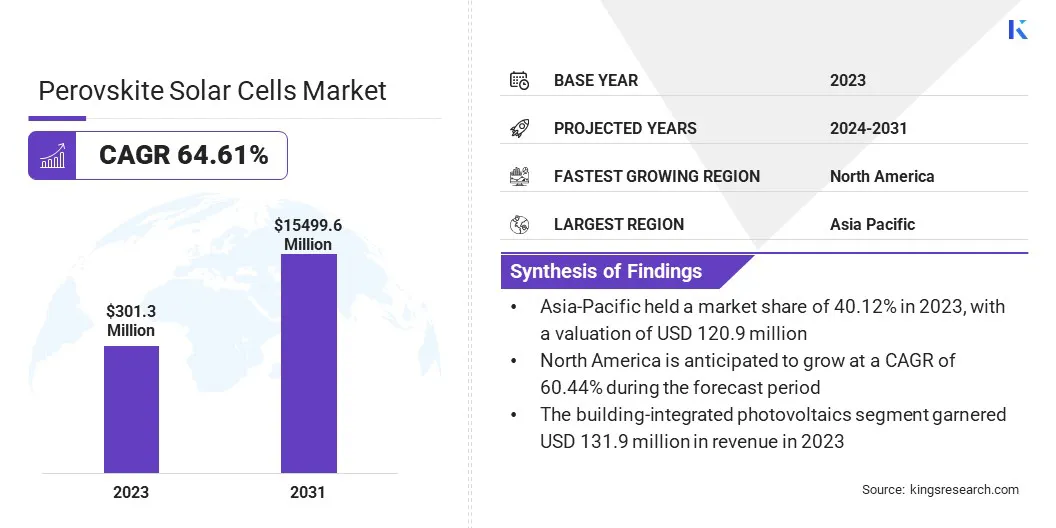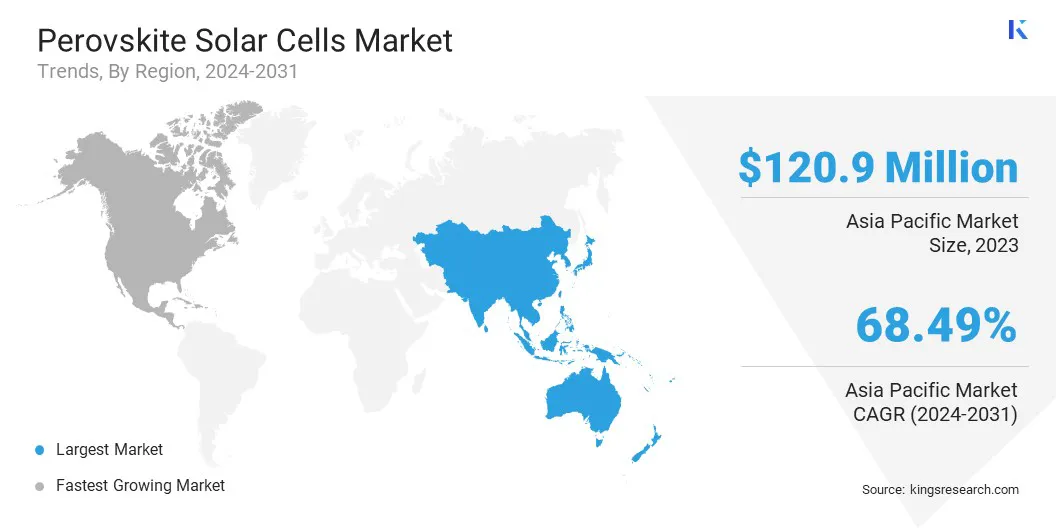Perovskite Solar Cells Market Size
The global Perovskite Solar Cells Market size was valued at USD 301.3 million in 2023 and is projected to grow from USD 473.2 million in 2024 to USD 15,499.6 million by 2031, exhibiting a CAGR of 64.61% during the forecast period. The market is expanding rapidly due to their increasing adoption in innovative applications in various sectors.
The growth of this market is fueled by technological advancements that enhance perovskite solar cells durability and efficiency. The sector is also benefiting from increasing collaboration between research institutions and industry players, which is driving breakthroughs in cell performance and integration. This dynamic environment is fostering accelerated adoption of perovskite solar cells, broadening their market opportunities.
In the scope of work, the report includes solutions offered by companies such as Saule Technologies, GCL-SI, UtmoLight Com.Ltd, Hunt Perovskite Technologies, shenzhen hiking pv technology co., Ltd, Hubei Wonder Solar LLC., Microquanta Semiconductor, Oxford PV , Greatcell Energy., EneCoat, Technologies Co., Ltd. , and others.
The perovskite solar cells market is witnessing significant growth due to their impressive efficiency, low production costs, and versatile applications. Government incentives and increased investments in sustainable energy technologies are accelerating product adoption. Additionally, advancements in flexible and wearable electronics are creating new opportunities for market expansion.
Ongoing research and development efforts are also focused on improving cell stability and performance, further driving innovation in the sector. These factors collectively enhance the market trajectory, positioning perovskite solar cells as a critical component supporting transition to renewable energy and contributing to the market expansion.
- In May 2023, the US Department of Energy announced USD 150 million in funding for the National Renewable Energy Laboratory (NREL) under the Inflation Reduction Act (IRA). This funding accelerated the research, development, and demonstration (RD&D) of new energy technologies and grid integration.
Perovskite solar cells are a cutting-edge photovoltaic technology that harnesses light-absorbing perovskite-structured materials to generate electricity from sunlight. Named after the mineral perovskite, these cells typically feature a perovskite layer sandwiched between electron and hole transport layers, placed on a substrate.
Known for their high efficiency, perovskite solar cells offer competitive performance compared to traditional silicon-based cells. In addition, their manufacturing process is relatively simple and cost-effective. These advantages make them an attractive alternative for solar energy applications.
With ongoing research aimed at improving their stability and scalability, perovskite solar cells are poised to play a significant role in the future of renewable energy.

Analyst's Review
Increasing investments is significantly driving market growth for perovskite solar cells. Increased financial support from governments, private investors, and research institutions is accelerating the development of advanced technologies and improving cell performance.
- In May 2023, Hanwha Qcells, a South Korean manufacturer of photovoltaic cells, revealed its plans to invest USD 100 million in a pilot production line for perovskite-tandem cells at its Jincheon factory. The pilot line is set to begin operations by 2024, aiming to assess the commercial viability and stability of this innovative technology.
Key players are capitalizing on investments in novel technologies like perovskite-tandem cells by accelerating their development and commercialization. Establishing pilot production lines is helping to validate and refine these innovations, leading to scalable and cost-effective solutions, thereby enhancing the market growth.
Perovskite Solar Cells Market Growth Factors
Perovskite solar cells are witnessing market growth due to their superior efficiency and cost-effectiveness. By delivering power conversion efficiencies that surpass traditional silicon-based solar cells, perovskite solar cells present a compelling value proposition for energy generation companies.
In addition, their streamlined manufacturing process, characterized by lower temperature requirements and reduced material usage, substantially lowers production costs. This combination of high performance and affordability accelerates their adoption across the renewable energy sector.
As a result, perovskite solar cells are emerging as a key solution to meet the increasing global demand for clean, cost-effective energy, which is propelling market expansion.
The perovskite solar cells market is facing challenges due to concerns regarding perovskite's long-term stability and durability in real-world environmental conditions. Degradation from moisture, UV radiation, and temperature fluctuations can significantly impact the efficiency and lifespan of perovskite cells.
These issues hinder their widespread adoption and commercial viability, as consistent performance and reliability are crucial for market acceptance. Key players mitigate these challenges by investing in advanced encapsulation techniques, developing more robust and stable perovskite materials, and conducting extensive field testing to enhance durability.
- For instance, in January; 2024, Tandem PV, a pioneer in perovskite solar technology, raised an additional USD 6 million, bringing the total of its venture capital and government support to USD 27 million in. The company plans to use these funds to advance its research and development efforts and build its first manufacturing facility.
Collaborations with research institutions and increased R&D funding are accelerating the development of solutions to improve the longevity and performance of perovskite solar cells, which is expected to drive the market growth over the forecast period.
Perovskite Solar Cells Industry Trends
Increasing government incentives and investments in sustainable energy technologies significantly boost the perovskite solar cells market. Governments worldwide are implementing favorable policies, subsidies, and tax incentives to promote the adoption of renewable energy sources. These financial incentives make it more attractive for businesses and consumers to invest in perovskite solar cells.
Additionally, substantial public and private investments are being channeled into research and development to enhance perovskite technology's efficiency, stability, and scalability. This influx of funding is accelerating innovation and commercialization efforts, enabling manufacturers to bring advanced perovskite solar products to market more rapidly, thereby driving market expansion.
The growing integration of perovskite solar cells in flexible and wearable electronic devices propels market growth. By offering a lightweight and thin form factor, these cells enhance the design and functionality of portable electronics, meeting the rising demand for sustainable and self-sufficient products.
- For instance, in May 2022, Saule Technologies, Columbus Energy, and Google Cloud began a strategic cooperation to innovate in the energy and IoT sectors using perovskite solar cells.
The ability of perovskite solar cells to provide continuous power on the go is driving significant advancements in consumer electronics, attracting substantial investments from manufacturers seeking innovation. This trend is expanding the application scope of perovskite technology and accelerating its adoption, which is expected to fuel the market over the forecast period.
Segmentation Analysis
The global market has been segmented on the basis of application, technology, type, and geography.
By Application
Based on application, the perovskite solar cells market has been categorized into building-integrated photovoltaics, power station, transportation & mobility, consumer electronics, and others. The building-integrated photovoltaics segment garnered the highest revenue of USD 131.9 million in 2023, driven by increasing urbanization and a strong emphasis on sustainable construction practices.
BIPV systems, which integrate solar panels directly into building materials like facades, roofs, and windows, enhance energy efficiency as well as architectural aesthetics. This growth is fueled by advancements in photovoltaic technology, favorable government incentives, and stringent green building regulations. Continuous innovation in materials and installation techniques is further accelerating segmental growth.
By Technology
Based on technology, the market has been categorized into vapor deposition, thermal evaporation, and others. The vapor deposition segment captured the largest perovskite solar cells market share of 46.34% in 2023. Vapor deposition techniques, such as chemical vapor deposition (CVD) and physical vapor deposition (PVD), are essential for creating high-quality perovskite layers with improved efficiency and precision.
Advances in deposition technology enhance film uniformity and reduce production costs, making perovskite solar cells more commercially viable. Increased research and development efforts further boost innovation in deposition methods while growing demand for efficient and cost-effective solar solutions is propelling market expansion.
By Type
Based on type, the market has been categorized into rigid and flexible segments. The rigid segment is expected to account for the highest revenue of USD 9,299.4 million by 2031. Rigid perovskite solar cells, characterized by their robust and inflexible substrate, offer superior stability and efficiency, making them suitable for fixed installations in residential, commercial, and industrial settings. Advances in perovskite materials and manufacturing processes are enhancing the performance and durability of rigid cells.
Increasing demand for efficient, high-output solar solutions is accelerating market growth, as rigid perovskite cells provide reliable energy generation and are becoming a preferred choice for large-scale and high-efficiency applications. The aforementioned advantages are expected to aid the segment growth over the forecast period.
Perovskite Solar Cells Market Regional Analysis
Based on region, the global market has been classified into North America, Europe, Asia-Pacific, MEA, and Latin America.

Asia-Pacific perovskite solar cells market share stood around 40.12% in 2023 in the global market, with a valuation of USD 120.9 million, mainly driven by rapid industrialization, urbanization, and a strong push toward renewable energy. Countries such as China, Japan, and South Korea are leading this market due to their significant investments in solar technology and ambitious clean energy targets.
- For instance, in August 2024, China’s GCL announced its plans to invest USD 98 million in tandem silicon/perovskite photovoltaic (PV) technology.
Additionally, the region is witnessing growing collaboration between research institutions and industry players, fostering innovation and expanding production capabilities. The development of cost-effective and high-efficiency perovskite solar cells is meeting the region's rising energy demands and supporting its transition to greener energy solutions, thereby driving market growth in the region.
North America is anticipated to witness significant growth at a CAGR of 60.44% over the forecast period, driven by technological advancements and increased investments in renewable energy. The region's strong R&D infrastructure, supported by numerous universities and research institutions, is a major driver for solar technology innovation.
Favorable government policies and substantial funding for clean energy initiatives further accelerate market development.
- In May 2023, American solar panel manufacturer, First Solar, acquired a Swedish startup, Evolar AB, for USD 38 million. Evolar's unique evaporation technology, enables the application of a thin-film layer of perovskite known as "PV Power Booster," technology that enhances cell energy yield by 25% at minimal cost.
This strategic acquisition highlights North America's commitment to improving solar cell efficiency and reducing production costs. These factors are likely to position North America as a key player in the global market, driving continued growth and investment over the forecast period.
Competitive Landscape
The global perovskite solar cells market report provides valuable insights with an emphasis on the fragmented nature of the industry. Prominent players focus on several key business strategies, such as partnerships, mergers and acquisitions, product innovations, and joint ventures, to expand their product portfolio and increase their market shares in different regions.
Companies are implementing impactful strategic initiatives, such as expanding services, investing in research and development (R&D), establishing new service delivery centers, and optimizing their service delivery processes, which are likely to create new opportunities for market growth.
List of Key Companies in Perovskite Solar Cells Market
- Saule Technologies
- GCL-SI
- UtmoLight Com.Ltd
- Hunt Perovskite Technologies
- shenzhen hiking pv technology co.,Ltd
- Hubei Wonder Solar LLC.
- Microquanta Semiconductor
- Oxford PV
- Greatcell Energy.
- EneCoat Technologies Co., Ltd.
Key Industry Development
- June 2024 (Product Development): Swift Solar, a leading American solar technology company, announced the completion of its USD 27 million Series A funding round. This achievement represents a major advancement for the production of cutting-edge perovskite solar technology in the U.S.
The global perovskite solar cells market has been segmented as follows:
By Application
- Building-Integrated Photovoltaics (BIPV)
- Power Station
- Transportation & Mobility
- Consumer Electronics
- Others
By Technology
- Vapor deposition
- Thermal evaporation
- Others
By Type
By Region
- North America
- Europe
- France
- U.K.
- Spain
- Germany
- Italy
- Russia
- Rest of Europe
- Asia-Pacific
- China
- Japan
- India
- South Korea
- Rest of Asia-Pacific
- Middle East & Africa
- GCC
- North Africa
- South Africa
- Rest of Middle East & Africa
- Latin America
- Brazil
- Argentina
- Rest of Latin America


